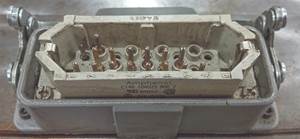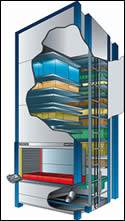How to Handle Your Heaviest Molds
Using the appropriate wheeled transporter technology moves large molds freely throughout the shop.
Moving molds that weigh 30 to 70 tons and more to and from the toolroom can be a chore, not to mention the time and effort the mold change crews spend in struggling to get the molds in and out of the machines. The use of the appropriate wheeled transporter technology offers a new option for moving the largest of molds freely between all areas of the plant.
The features to consider in your selected wheel transporter technology include:
- The capability of carrying unlimited weight across virtually any type of existing plant floor. It should have six, eight, 10 or more axle assemblies that are individually fluid suspended to assure that every tire is carrying only its share of the load, regardless of depressions, ramps or other serious floor irregularities.
- Omni directional travel ability, which allows the vehicle to travel sideways, rotate about its own center as well as lift and lower at the touch of a button. These features provide mobility that has never before been available for moving massive loads through congested spaces. For the toolroom, this means freeing up valuable space, because molds can be stored almost anywhere, yet still have near instant access for processing.
- Either a self-loading mold changer that carries molds at near the right height for machine insertion or a very low-deck platform carrier that transports molds between process areas and to and from the toolroom.
- Every wheel should have its own drive motor to accommodate travel and steering. Differential steering is accomplished by varying the wheel’s rotation speeds or even reversing the rotation as necessary for whatever maneuver the operator directs. The complexity of controlling the speed and direction of every wheel on these multi-axle carriers becomes a simple task for the onboard computerized control. The operator simply controls all movement with great precision from a tiny joystick on a tethered handheld remote.
Mold Change in Action
In a typical mold change with the right wheeled transporter technology, ready molds will be taken from a storage area and can be carried on either or both of the twin roller decks. For an actual mold change, the operator will maneuver the transporter in parallel to the next machine due for a mold change. The operator will stop with an empty roller deck roughly laterally aligned with the mold to be removed. With a touch of a button, all of the axles will turn 90 degrees and the transporter will now move sideways to the side of the machine. The outriggers will lower and the entire transporter will be lifted to a matching height with the platen rollers.
When the spent mold has been rapidly brought onboard and secured, the transporter will lower to floor contact, where again all of the wheels turn to move the transporter forward to align for insertion of the new mold. Again the outriggers lift the transporter to the required height and the new mold is rolled into the machine—quickly, efficiently and safely.
Using all-wheel drive and all-directional steering, wheeled transporter technology can travel on 12 to 20 or more solid urethane tires. If the loaded transporter is going to stop for any extended period of time, the transporter simply lowers to trans-fer its weight onto outrigger pads to avoid temporary flats.
In a busy toolroom, space is often a serious problem. Having that capability to move molds freely and quickly to remote storage areas can put a new element in a toolroom’s list of capabilities.
Related Content
Questions and Considerations Before Sending Your Mold Out for Service
Communication is essential for proper polishing, hot runner manifold cleaning, mold repair, laser engraving and laser welding services.
Read MoreHow to Use Thermal Management to Improve Mold Cooling
A review of common mold cooling issues and possible solutions, including 3D printing applications.
Read MorePrecision Welding Services Offer Rapid Turnaround Mold Repair and Reduced Molder Downtime
X-Cell Tool & Mold relies on outsourced, high-quality welding repairs from Lewis-Bawol Welding to ensure its customers' molds are back in production quickly and affordably.
Read MoreHow to Maintain Heaters, Thermocouples, Valve Gates and Controls
An examination of real-world problems and solutions involving hot runner system maintenance.
Read MoreRead Next
Selecting a Vertical Storage And Retrieval System for Moldmaking Applications
Vertical systems, when properly planned and integrated into daily operations, can significantly reduce operating costs.
Read MoreHow to Use Continuing Education to Remain Competitive in Moldmaking
Continued training helps moldmakers make tooling decisions and properly use the latest cutting tool to efficiently machine high-quality molds.
Read MoreAre You a Moldmaker Considering 3D Printing? Consider the 3D Printing Workshop at NPE2024
Presentations will cover 3D printing for mold tooling, material innovation, product development, bridge production and full-scale, high-volume additive manufacturing.
Read More











_300x250 1.png;maxWidth=300;quality=90)


.jpg;maxWidth=300;quality=90)










